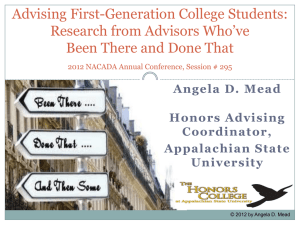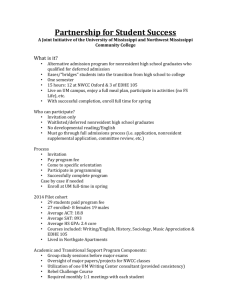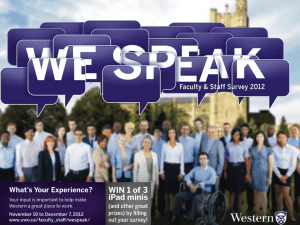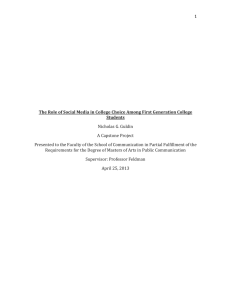First Generation Scholarly Learning Community White Paper
advertisement
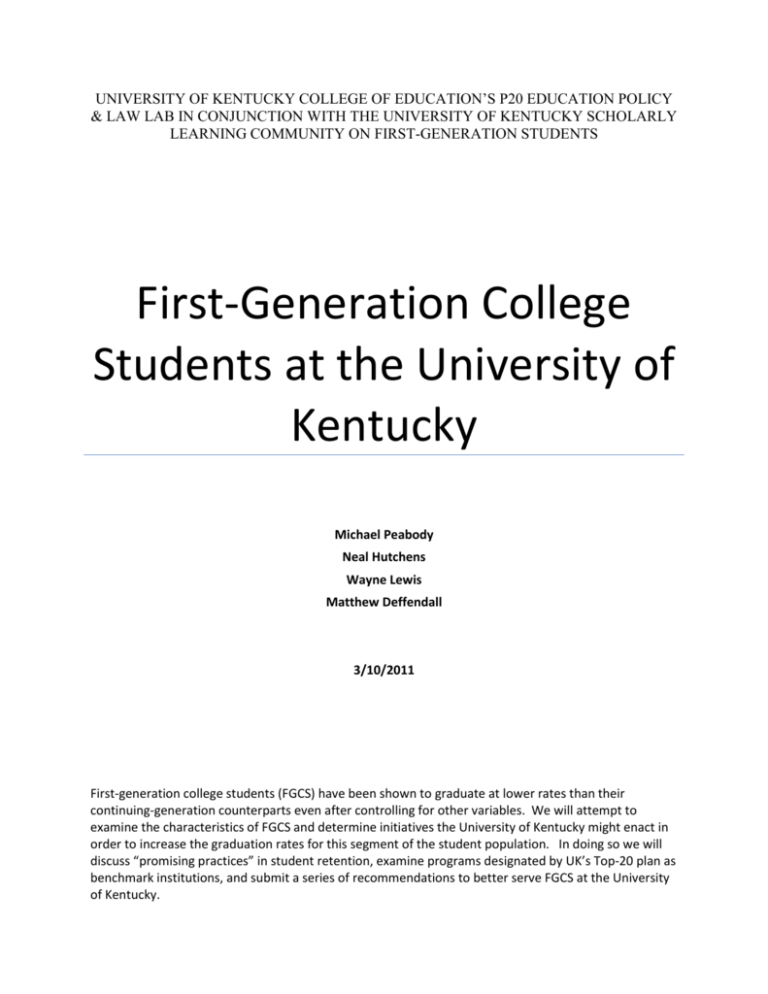
UNIVERSITY OF KENTUCKY COLLEGE OF EDUCATION’S P20 EDUCATION POLICY & LAW LAB IN CONJUNCTION WITH THE UNIVERSITY OF KENTUCKY SCHOLARLY LEARNING COMMUNITY ON FIRST-GENERATION STUDENTS First-Generation College Students at the University of Kentucky Michael Peabody Neal Hutchens Wayne Lewis Matthew Deffendall 3/10/2011 First-generation college students (FGCS) have been shown to graduate at lower rates than their continuing-generation counterparts even after controlling for other variables. We will attempt to examine the characteristics of FGCS and determine initiatives the University of Kentucky might enact in order to increase the graduation rates for this segment of the student population. In doing so we will discuss “promising practices” in student retention, examine programs designated by UK’s Top-20 plan as benchmark institutions, and submit a series of recommendations to better serve FGCS at the University of Kentucky. TABLE OF CONTENTS Executive Summary 2 Introduction 4 Characteristics of First-Generation College Students 5 “Promising Practices” in Student Retention 7 What is happening at UK’s Top-20 Benchmark Institutions? 11 Retention Programs at UK 13 Issues Relating to FGCS at UK 14 Recommendations 16 References 19 1 EXECUTIVE SUMMARY First-generation college students (FGCS) represent one-third of all students at public four year institutions and half of all students at public two year institutions. FGCS have also been found to graduate at lower rates than students whose parents graduated from college. Students who have had at least one parent attend college graduate at a rate of 67.5%, while FGCS graduate at a rate of 23.5%. Characteristics of FGCS often low-income more likely to be an ethnic minority generally older than continuing-generation college students more likely to be a non-native English speaker more likely to live at home or off-campus often take fewer credits or enroll part-time often work full-time Promising Practices peer mentoring faculty mentoring freshman seminar career counseling summer bridge parent programs student organizations living-learning communities Benchmark Institutions An analysis of UK’s Top 20 plan benchmark institutions shows that most of these institutions provide services to FGCS through the US Department of Education’s TRiO programs. However, institutions such as Michigan and Virginia offer no institutional-wide support services specifically for FGCS at their main campuses. 2 FGCS at UK There are several FGCS programs at UK including Robinson Scholars, First Scholars, and Student Support Services. Although these programs all target specific sub-populations of FGCS, they may have some overlap in the students served. Significantly, in their current capacities these three programs are only equipped to assist a small percentage of the FGCS population at UK. Issues Related to FGCS at UK Another issue that has become problematic relating to FGCS at UK is that of data collection and identification. These students have been self identified by a single question on the admissions application, which creates a host of problems with the collection of reliable information. In order to make accurate and informed decisions concerning FGCS programming and initiatives it is imperative to develop a clearer data picture of FGCS at UK. While a reformulated question was included on the admissions application in 2011, further efforts may be warranted in relation to identifying FGCS at UK and data collection related to these students. Recommendations We recommend better data collection and coordination between departments such as financial aid, admissions, and advising to more accurately identify these students in order to provide a better institutional data picture of FGCS at UK. We also recommend a consolidated resource center for the housing of all FGCS programs, expansion of K-Week to include a FGCS 3 summer bridge program, and seeking to incorporate a Ronald McNair Postbaccalaureate Achievement Program into UK’s current TRiO program. INTRODUCTION First-generation college students (FCGS) represent fully one-third of the student population at public four year institutions and half of the population at two year and community colleges (Choy, 2001). At the University of Kentucky (UK), the Office of Institutional Research, Planning, and Effectiveness reported the percentage of FGCS for the 2008 cohort to be 23% of the entering class. However, this number is likely an under-representation due to the fact that first-generation student status is self-reported on the admissions application by a single question; and since FGCS often lack knowledge of institutional procedures (Choy, 2001; Engle, Bermeo, & O’Brien, 2006; Nunez & Cuccaro-Alamin, 1998; Pike & Kuh, 2005; Reid & Moore, 2010), they may not fully understand the question and whether it applies to them or not and leave the item blank. Given this probable under-reporting the population of FGCS at UK could easily reach the 30% national average identified by Choy (2001). FGCS persist and graduate at lower rates than students whose parents graduated college, herein referred to as continuing-generation students (Bui, 2002; Chen & Carroll, 2005; Choy, 2001; Engle & Tinto, 2008; Ishitani, 2006; Pascarella, Pierson, Wolniak, & Terenzini, 2004). Only 23.5% of FGCS attain bachelor degrees compared to 67.5% of students who had at least one parent attain a bachelor’s degree (Chen & Carroll, 2005). FGCS are also less likely to be enrolled at a four year institution after three years than their continuing-generation counterparts by a rate of 68% to 86% (Warburton, Bugarin, & Nunez, 2001). 4 With FGCS comprising such a large portion of a campus population at UK, it is important to note that while retention strategies that work for FGCS are likely to be successful for the general student population, strategies designed for the general campus population are not necessarily effective in retaining first-generation students (Thayer, 2000). Thus, specific programmatic efforts aimed at FGCS can also serve the overall student population and may increase overall student retention and persistence to graduation, but the reverse is not necessarily true. CHARACTERISTICS OF FGCS Several different definitions exist of what it means to be a first-generation college student. Some organizations refer to FGCS as those students whose parents have no formal education beyond high school. Others classify FGCS as those who have at least one parent with some education after high school, but did not attain a degree. Other definitions allow both parents to have had some higher education, but with neither having completed a degree. The U.S. Department of Education, through the Higher Education Act (2008), defines a FGCS as: “An individual both of whose parents did not complete a baccalaureate degree; or in the case of any individual who regularly resided with and received support from only one parent, an individual whose only such parent did not complete a baccalaureate degree.” In spite of the formal US Department of Education’s definition most of the research on FGCS focuses on the definition in which neither parent has any higher education experience. Therefore, in this paper we adopt the definition in which neither parent has any formal education beyond high school. 5 The background characteristics of FGCS have been studied extensively and research has shown that FGCS tend to exhibit the following characteristics: often low-income (Bui, 2002; Chen & Carroll, 2005; Choy, 2001; Engle et al., 2006; Jenkins, Miyazaki, & Janosik, 2009; Warburton et al., 2001) more likely to be ethnic minority (Bui, 2002; Chen & Carroll, 2005; Choy, 2001; Engle et al., 2006; Engle & Tinto, 2008; Warburton et al., 2001) generally older than non-FGCS (Choy, 2001; Engle et al., 2006; Engle & Tinto, 2008; Warburton et al., 2001) more likely to be a non-native English speakers (Bui, 2002; Engle & Tinto, 2008; Warburton et al.,2001) more likely to live at home or off-campus (Engle et al., 2006; Engle & Tinto, 2008; Pascarella et al., 2004) often take fewer credits or enroll part-time (Choy, 2001; Engle et al., 2006; Engle & Tinto, 2008; Nunez & Cuccaro-Alamin, 1998; Terenzini, Springer, Yaeger, Pascarella, & Nora, 1996) often work full-time (Pascarella et al, 2004; Terenzini et al., 1996) In addition to these background characteristics, FGCS tend to be less academically prepared entering college and take more remedial classes once enrolled (Chen & Carroll, 2005; Engle et al., 2006; Nunez & Cuccaro-Alamin, 1998; Warburton et al., 2001). Approximately 55% of FGCS take remedial courses compared to 27% of continuing-generation students (Chen & Carroll, 2005) and the average SAT scores for FGCS were 858 compared to 1011 for continuing6 generation students (Warburton et al, 2001). Other academic characteristics include low educational and degree aspirations (Chen & Carroll, 2005; Choy, 2001; Terenzini et al., 1996) and a lower likelihood of applying to graduate school by a rate of 25% for FGCS and 34% for continuing-generation students (Choy, 2001). Once on campus FGCS are less likely to integrate into the campus culture (Bryan & Simmons, 2009; London, 1989; Pike & Kuh, 2005), mostly due to the fact that, as mentioned, FGCS tend to be more likely to live off-campus and work more hours than continuinggeneration students. Also, FGCS are less likely to perceive faculty as caring and approachable (Jenkins et al., 2009; Pike & Kuh, 2005) and have less understanding of the university institutional bureaucracy (Bui, 2002; Engle et al., 2006). In sum, FGCS are more likely to be low-income, minority, older, and non-native English speakers, live off-campus, work more, take fewer classes, take more remedial courses, and have lower standardized test scores. They are also less likely to approach a faculty member if struggling in a class, less likely to be aware of institutional programs and services like tutoring centers, and less likely to consider applying for graduate school. “PROMISING PRACTICES” IN STUDENT RETENTION To aid in the consideration of strategies to help improve institutional support for FGCS at UK, below are some “promising practices” discussed in the student development literature and representing some of the more popular and successful retention programs for FGCS: Peer Mentoring. Many successful student retention programs incorporate aspects of peerassisted initiatives. Programs such as peer-tutoring, peer-mentoring, peer-counseling, and 7 peer-academic advising have been incorporated into student retention programs. The proliferation of peer-initiated programs has coincided with a time of diminishing financial resources and would seem to be beneficial in terms of student retention and success, as well as financially expedient as most peer programs can be designed with low to no cost (SanchezLeguelinel, 2008). Not only are peer initiated programs beneficial for the mentee, but mentors may also experience higher levels of campus involvement that may lead to higher retention and persistence rates (Stokes, 1988). Mentors may also experience greater academic success due to their involvement in teaching study and test taking skills and incorporating those skills into their own academic arsenals (Good, Halpin, & Halpin, 2000). Faculty Mentoring. A study by R. Longwell-Grice and H. Longwell-Grice (2008) revealed that first-generation students often view faculty members as “gatekeepers” who are tasked with “weeding-out” those students who are not capable or serious about their studies. These students may also view faculty as being uncaring, indifferent, and even hostile towards students who seek additional assistance outside of class. First-generation students often need the most assistance and derive the greatest benefit from contact with faculty (Pascarella et al, 2004), but at the same time they are typically reluctant to ask for help (Longwell-Grice & Longwell-Grice, 2008). Freshman Seminar. Freshman seminar courses are similar to Summer Bridge programs with the primary difference being breadth and depth. However, there are several benefits to extending these programs into full semester length courses. First, it allows for a much more indepth look at a range of topics. Second, it allows for topics to be introduced as they arise 8 during the semester. For example, the issue of test taking skills may be introduced just before mid-term exams. Third, the full semester length course allows for student feedback as well as oversight and support from the instructor throughout the semester (Cuseo, 1991). Career Programming. Career programming for first-generation college students means more than simply directing them to the campus career center; it means helping them to develop a sense of inquiry towards a selection of major and potential career choices. Affirming the link between major and potential career will also help retain students by giving them a clear focus on the long-term intentions and benefits of higher education (Ayala & Striplen, 2002). Creating a program in conjunction with the career center can greatly enhance a first generation college student’s sense of self-efficacy and a willingness to consult the resources available at the career center. Summer Bridge Program. Summer Bridge or other transitional programs are designed to assist targeted student populations make the requisite adjustments from high school to college-level course work. These programs often consist of both academic and social components focusing on math and English composition skills, as well as providing guidance in learning how to use campus resources and student support services (McCurrie, 2009). A 1996 study by Santa Rita and Bacote sought to determine the benefits of summer bridge programs for minority and lowincome students, in which they concluded that summer bridge programs “can help facilitate . . . [the] transition and adjustment to college life and improve persistence rates.” Parent Programs. One of the most critical issues facing first-generation college students is that of their parent’s lack of knowledge and understanding about what it will take for the student to 9 succeed. Students often struggle to establish a connection to campus while simultaneously maintaining their role within the family (London, 1989). The issue of “pull-back” or students returning home to assist with child care, work, or other family responsibilities often takes them off campus during a time when research has shown that co-curricular involvement is positively correlated to student success (Pascarella et al, 2004). Programs designed to assist parents in understanding the issues facing college students can be very significant in aiding firstgeneration students in overcoming these common challenges. Student Organizations. First-generation college students exhibit a number of characteristics that distinguish them from their continuing-generation college student contemporaries. As many first generation students both live and work off-campus, they may not become well integrated into supportive and positive aspects of campus life. Astin’s (1984) research indicated a positive correlation between campus involvement and college success. A firstgeneration student organization can provide some connection to the campus for firstgeneration students through a common peer group with a sense of shared experiences. A student organization can also provide a base of knowledge from which first-generation students can begin to learn about the campus environment and potential resources to aid in their success. Living-Learning Communities. Living-learning communities are residence hall communities that bring together curricular and co-curricular learning into the everyday lives of students. Often, these communities are designed to provide students the opportunity to live with other students from a common background or who share common interests. Living-learning communities 10 offer special programming in the residence hall and often incorporate opportunities to interact with faculty and staff members outside of their official capacity in such a way as to encourage further interaction between students and campus administration (Stassen, 2003; Inkelas, Daver, Vogt, & Leonard, 2006). First-generation students tend to focus more on academics and class assignments rather than social issues (Pascarella et al, 2004). This academic focus lends to firstgeneration students viewing important social integration issues and peer-contact as superfluous to a college education and when they do engage in social interactions they tend to rely heavily on structured formal events (Inkelas et al, 2006). Living-learning communities provide a way for important peer-interactions to occur under the banner of a formal event and therefore lend more credence to the interaction for a first generation student (Inkelas et al, 2006). BENCHMARK INSTITUTIONS As the University of Kentucky strives to become a “Top 20 Public Research University” it continuously measures itself against benchmark institutions, or those institutions with which comparison informs decision-making to promote program change and enhancements. Our study was begun in the fall of 2009 using the Kentucky Council for Post-Secondary Education’s (CPE) 19 benchmark institutions. During the course of preparing the report, the University of Kentucky adopted a policy that benchmark analyses would rely on the 20 benchmark institutions identified in UK’s “Top 20 Business Plan.” Some, but not all of these, correspond with the CPE benchmarks. For the purposes of this report we have continued using our original set of 19 CPE benchmark institutions. As represented in the table below, the following are 11 various strategies or programs adopted at benchmark institutions intended to assist FGCS. Meant to be illustrative of promising practices, the chart represents the adoption of programs at main campuses and institution-wide in scope. Thus, certain programs at branch campuses or adopted at the college or department level have not been listed. X X WASH. VIRGINIA UCLA TAMU PURDUE X KENTUCKY X WISCONSIN X PENN ST OHIO ST NC STATE UNC MINNESOTA MICH ST MICHIGAN MARYLAND IOWA X ILLINOIS X GEORGIA FLORIDA PEER MENTORING FACULTY MENTORING FRESHMAN SEMINAR CAREER PROGRAMMING SUMMER BRIDGE PARENT PROGRAM STUDENT ORGANIZATION LIVINGLEARNING ARIZONA COMPARISON OF PROMISING PRACTICES AT BENCHMARK INSTITUTIONS X X X X X X X X X X X X X X X X X X X X X X X X X X X 1. Georgia offers the Coca-Cola First Generation Scholarship, but there is no programmatic aspect to accompany the award. 2. NC State instituted a TRiO program on Sept 1, 2010. Currently it deals primarily with academic advising and tutoring. 3. Texas A&M offers the Regent’s Scholarship, but there is no programmatic aspect to accompany the award. 4. Ohio State claims a student organization, but it appears to be inactive. 5. Virginia and Michigan offer no services specific to first-generation college students. Most benchmark institutions seek to target FGCS under the auspices of the U.S. Department of Education’s TRiO programs. The TRiO program provides assistance to lowincome, first-generation, and individuals with documented disabilities by funding programs such as Student Support Services, Ronald E. McNair Postbaccalaureate Achievement Program, 12 Upward Bound, and Educational Talent Search. Student Support Services (SSS) is by far the most popular TRiO program and includes services such as academic tutoring, academic advising, financial aid advising, graduate school counseling, cultural diversity experiences, mentoring programs, and career counseling. Participating institutions are not required to provide all of these services, and so we have chosen to list them separately in the above table in order to give a more complete picture of the services provided by benchmark institutions. FGCS RETENTION PROGRAMS AT UK There are three programs at UK designed for FGCS; Student Support Services, Robinson Scholars Program, and First Scholars. Student Support Services was established at UK more than 20 years ago and offers services such as personal counseling, academic advising, career counseling, graduate school preparation, tutoring, peer mentoring and academic skills preparedness. Students must apply to receive services through SSS and UK currently has the funding to provide services to 160 students. Since FGCS may compose nearly one-third of the student population, which would be at least 936 incoming freshmen in 2008, this program is only equipped to service a small percentage of the FGCS population. The Robinson Scholars Program, established in 1997, is open to low-income, firstgeneration students from 29 counties in eastern Kentucky. This program is competitive and only one student from each of the 29 service counties is entered into the program. The program begins in high school and assists students with the transition into university life. Robinson Scholars receive a full tuition and room and board scholarship for eight semesters and are required to live on campus for the first two years. Services such as a summer transition 13 program, academic advising, personal counseling, peer mentoring, freshman seminar course, and other various workshops are offered to the nearly 100 students currently participating in the program. Participation in peer mentoring sessions, freshman seminar course, and various workshops is required in order for students to continue to receive the scholarship, which includes tuition and fees, room and board, and a textbook allowance. Established in 2009, the First Scholars program is a grant funded affiliate of the First Scholars program of the Suder Foundation. This program is open to FGCS who agree to live on campus for their first year and meet minimum academic qualifications. In return, students receive a $5,000 scholarship. Participants are also required to participate in a peer-mentoring program as well as volunteer on campus and in the community. The director of the First Scholars program also currently serves as an advisor to the UK First-Generation Student Organization, which was formed in 2010 and is still in its infancy. The First Scholars program enrolls 20 students each fall semester and will eventually have the capacity to provide services to 80 students. Finally, these three programs, in conjunction with the UK Office of Residence Life, have initiated the establishment of a living-learning community. This new living-learning community will eventually house approximately 80 FGCS on UK’s South Campus in Fall 2011. Exact programmatic details are still under development. The University of Cincinnati’s First-Gen House, which has served as a model for UK’s effort, made national news with articles in The New York Times, USA Today, and Inside HigherEd.com when it opened. UK’s effort will place it among the leaders in regard to programs for FGCS, including among our benchmark institutions. 14 ISSUES RELATED TO FGCS AT UK A key issue identified in relation to improving retention strategies for FGCS at UK involves the need for improved data collection. Currently, the only way that FGCS at UK are identified is through a question on their admissions application, which previously asked, “Are you a first generation college student? (Neither parent attended college)*”. As a matter of university policy UK adheres to the definition of first-generation given by the U.S. Department of Education (USDE). The USDE definition merely requires that neither parent have completed a bachelor’s degree. During the course of preparing this report, it was learned that the admissions application at UK will be revised with a question to reflect the USDE definition and to improve identification of FGCS. Even with the changed question for the admissions application, under-identification may still occur. As such, other efforts, such as relying on academic advisors to help identify FGCS, are warranted. In addition to improving the identification of FGCS there is the issue of identifying and serving the entire FGCS population at UK. Currently, reports from the Office of Institutional Research, Planning, and Effectiveness only consider first-time, full-time, incoming freshmen in their analysis of FGCS. However, this does not take into consideration spring enrollees, transfer students, and students who have taken a leave of absence and re-enroll. The following chart shows the retention and graduation rates for first-generation college students within a six year reporting period. We begin by pointing out that there were FGCS at UK prior to 2006, but the data on these students was not uniformly collected and for the sake of an accurate analysis has been left out of this report. At this point it is important to note that this report deals only with first-time, full-time students and, therefore, does not 15 include spring semester enrollees, transfer students, or part-time students. Also, as discussed previously, FGCS status is self-reported and so it is likely that the disparity in retention and graduation rates are even greater than presented here. UNIVERSITY OF KENTUCKY OFFICE OF INSTITUTIONAL RESEARCH REPORT ON PERFORMANCE OF FIRST-YEAR, FULL-TIME STUDENTS AS OF FEBRUARY 1, 2011 *GRADUATION RATES FOR THE FALL 2004 AND 2006 COHORTS ARE PRELIMINARY FIRST FALL TO FIRST FALL TO FIRST FALL TO FOUR YEAR SIX YEAR FIRST FALL FIRST SPRING SECOND FALL THIRD FALL DEGREE DEGREE ENROLLMENT RETENTION RETENTION RETENTION COMPLETION COMPLETION COHORT 2006 2007 2008 2009 2010 FIRST GENERATION NO YES NO YES NO YES NO YES NO YES N N % N % N % N % 3396 722 3210 625 3374 705 3393 718 3305 977 3073 613 2964 544 3136 629 3214 672 90.49 84.90 92.34 87.04 92.95 89.22 94.72 93.59 2650 495 2642 462 2751 524 2829 532 78.03 68.56 82.31 73.92 81.54 74.33 83.38 74.09 2389 426 2357 371 2449 448 70.35 59.00 73.43 59.36 72.58 63.55 990 148 29.15 20.50 N % HS GPA FIRST FIRST ACT FALL YEAR COMP UK UK GPA GPA MEAN MEAN MEAN MEAN 3.48 3.46 3.49 3.43 3.52 3.50 3.53 3.47 3.62 3.55 24.20 23.13 24.52 23.26 24.59 23.49 24.91 23.62 25.49 24.25 2.7 2.4 2.8 2.5 2.8 2.6 2.9 2.6 3.0 2.6 2.6 2.4 2.8 2.5 2.8 2.6 2.8 2.6 As the data reveal, FGCS at UK trail their continuing-generation counterparts in every category for every cohort in this report. The following are strategies that UK could consider adopting to assist in raising the retention and graduation rates of first-generation college students. RECOMMENDATIONS A review of research on FGCS, current practices and programs at UK, and “promising” practices at UK benchmark schools and other institutions reveals several potential strategies to improve retention and graduation efforts at UK. 16 To better identify and track FGCS at UK, the collection of data related to FGCS needs to be strengthened. One step, already underway, is to revise the question on the UK admissions application so that students are provided more detailed information regarding who qualifies as a first-generation student based on UK’s definition of FGCS. Additionally, to compensate for under reporting that may likely occur, other mechanisms should be adopted to identify FGCS. One strategy would be to enlist the assistance of undergraduate advisors to create partnerships and collaborations across campus in an effort to help identify FGCS who may not have appropriately identified themselves on the admissions application. It is likely that as long as FGCS status is left to be completely self-reported, then the percentage of FGCS at UK will likely continue to be underreported. Based on research and promising practices, we also recommend a centralized office or resource center that can provide a one-stop-shop for all FGCS services on campus. Currently, Robinson Scholars and First Scholars are located across the hall from each other in Funkhouser Building, while Student Support Services is located in Alumni Gym. We believe that grouping RSP, First Scholars, and SSS in the same building as The Study and other student success initiatives can only help to encourage students to use all resources available to them. In addition, placing students who are “at-risk” in proximity to other Undergraduate Education programs like the Honors Program, Discovery Seminar, Service Learning Program, and the Intercollegiate Debate Program can only help to provide a positive environment to assist in student retention and persistence. Additionally, we recommend the expansion of K-Week into a “summer bridge” program for FGCS and seeking a grant to include the Ronald McNair Postbaccalaureate Achievement 17 Program to UK’s current TRiO programming. This set of improvements would likely be a simple and cost-effective strategy to enhance FGCS retention. A summer bridge program could be specific to FGCS and provide needed institutional information at a marginal cost as well as introduce an aspect of career programming that is currently missing from the K-Week experience. The Ronald McNair Achievement Program has proven itself successful at sending program participants to graduate school, as evidenced by its 72.3% three-year graduate school enrollment rate (U.S. Department of Education, n.d.). We would also encourage current FGCS programs to initiate a stronger association with the Stuckert Career Center, as first-year seminar programs in conjunction with campus career centers have been shown to be particularly successful for FGCS (Ayala & Striplen, 2002). In sum, FGCS remain an underserved population not only at the University of Kentucky, but nationwide as well. An examination of benchmark institutions has shown that although UK offers programs comparable in size and scope with national norms, the university is still lacking some key components necessary for the success of this portion of the student population. The recommendations offered in this report represent strategies backed by research and programs at other institutions that have improved the retention and graduations rates of FGCS. 18 REFERENCES Astin, A. (1984). Student involvement: A developmental theory for higher education. Journal of College Student Development, 25, 297-308. Astin, A., & Sax, L. (1998). How Undergraduates Are Affected by Service Participation. Journal of College Student Development, 39 (3), 251-263. Ayala, C., & Striplen, A. (2002). A Career Introduction Model for First-Generation College Freshman Students. ED 469 996. Bryan, E., Simmons, L. (2009). Family involvement: Impacts on post-secondary educational success for firstgeneration Appalachian college students. Journal of College Student Development. 50(4), 391-406. Bui, K. (2002). First-generation college students at a four-year university: Background characteristics, reasons for pursuing higher education, and first-year experiences. College Student Journal. 36(1), 3-11. Chen, X., & Carroll, D. (2005). First generation Students in Postsecondary Education. A look at their College Transcripts. Postsecondary Education Descriptive Analysis Report (NCES 2005171). Washington, DC: U.S. Department of Education, National Center for Education Statistics. Choy, S. (2001). Essay: Students Whose Parents Did Not Go To College: Postsecondary access, persistence, and attainment. In J. Wirt, et al. (Eds.), The condition of education 2001(pp. XVIII-XLIII). Washington, DC: National Center for Education Statistics, U.S. Government Printing Office. Cuseo, J. (1991). The Freshman Orientation Seminar: A Research-Based Rationale for Its Value, Delivery, and Content. (Monograph No. 4). Columbia, SC: National Resource Center for The Freshman Year Experience, University of South Carolina. Engle, J., Bermeo, A., & O’Brien, C. (2006). Straight from the Source: What Works for First-Generation College Students. Washington, DC: Pell Institute for the Study of Opportunity in Education. Engle, J., & Tinto, V. (2008). Moving Beyond Access: College Success for Low-Income, First-Generation Students. Washington, DC: The Pell Institute for the Study of Opportunity in Education. Good, J., Halpin, G., & Halpin, G. (2000). A Promising Prospect for Minority Retention: Students Becoming Peer Mentors. Journal of Negro Education, 69, 375-383. Habley, W., & McClanahan, R. (2004). What Works in Student Retention. Iowa City, IA: ACT, Inc. Higher Education Act. (2008). 20 U.S.C. § 1070a-11(h)(3). The Higher Education Act was re-authorized and amended with the 2008 Higher Education Opportunity Act (Public Law 110-315), which included a definition for FGCS. Inkelas, K., Daver, Z., Vogt, K., & Leonard, J. (2006). Living-Learning Programs and First-Generation college students’ academic and social transition to college. Research in Higher Education, 48, 403-434. Ishitani, T. (2006). Studying attrition and degree completion behavior among first-generation college students in the United States. Journal of Higher Education. 77(5), 861-885. 19 Jenkins, A. L., Miyazaki, Y., & Janosik, S. M. (2009). Predictors that Distinguish First generation College Students from Non-First Generation College Students. Journal of Multicultural, Gender and Minority Studies. 3 (1), 1-9. London, H. (1989). Breaking Away: A Study of First Generation College Students and their Families. American Journal of Education, 97 (2), 144-170. Longwell-Grice, R., & Longwell-Grice, H. (2008). Testing Tinto: How do retention theories work for first-generation, working-class students? Journal of College Student Retention, 9, 407-420. Nunez, A., & Cuccaro-Alamin, S. (1998). First generation students: Undergraduates whose parents never enrolled in postsecondary education (NCES 98082). Washington, DC: U.S. Department of Education, National Center for Education Statistics. McCurrie, Matthew. (2009). Measuring Success in Summer Bridge Programs: Retention Efforts and Basic Writing. Journal of Basic Writing, 28, 28-49. Pascarella, E., Pierson, C., Wolniak, G., & Terenzini, P. (2004). First-Generation College Students. Journal of Higher Education, 75, 249-284. Pike, G., Kuh, G. (2005). First- and second-generation college students: A comparison of their engagement and intellectual development. Journal of Higher Education. 76(3), 276-300. Reid, M., & Moore, J. (2010). College Readiness and Academic Preparation for Postsecondary Education: Oral Histories of First-Generation Urban College Students. Urban Education, 43, 240-261. Sanchez-Leguelinel, C. (2008). Supporting ‘Slumping Sophomores: Programmatic Peer Initiatives Designed to Enhance Retention in the Crucial Second Year of College. College Student Journal, 42, 637-646. Santa Rita, E., & Bacote, J. (1996). The Benefits of College Discovery Prefreshman Summer Programs for Minority and Low Income Students. ED 394 536. Schambach, T, & Dirks, J. (2002). Student Perceptions of the Internship Experience. ED 481 733. Schuh, J. (2005). Finances and Retention: Trends and Potential Implications. In A. Seidman (Ed.) College Student Retention (277-294). Westport, CT: American Council on Education and Praeger Publishers. Stassen, M. (2003). Student Outcomes: The impact of varying living-learning community models. Research in Higher Education, 44, 581-613. Stokes, D., Gonzalez, M., Rowe, D., Romero, D., Adams, M., Lyons, S., & Rayfield, G. (1988). Multicultural Peer Counseling: A Developmental perspective and rationale. Journal of Counseling and Development, 67, 5556. Swail, W., & Perna, L. (2002). Pre-College Outreach Programs. In Tierney, W. & Hagedorn, L. (Eds.), Increasing Access to College: Extending Possibilities for All Students (15-34). Albany, NY: State University of New York Press. Swanson, D. (2006). Creating a Culture of ‘Engagement” with Academic Advising: Challenges and Opportunities for Today’s Higher Education Institutions. Paper presented at Western Social Science Association convention (Phoenix, Arizona April 21, 2006) 20 Terenzini, P., Springer, L., Yaeger, P., Pascarella, E., & Nora, A. (1996). First-Generation college students: Characteristics, experiences, and cognitive development. Research in Higher Education. 37(1), 1-22. Thayer, P. (2000). Retention of Students from First Generation and Low Income Backgrounds. Journal of the Council for Opportunity in Education, May 2000, 3-9. Tinto, V. (1975). Dropout from higher education: A theoretical synthesis of recent research. Review of Educational Research, 45, 89-125. Tinto, V. (1993). Leaving College: Rethinking the Causes and Cures of Student Attrition. 2nd ed. Chicago: University of Chicago Press. U.S. Department of Education. (n.d.). Data from the U.S. Department of Education, Federal TRIO Programs, Ronald E. McNair Postbaccalaureate Achievement Program Annual Performance Reports, 2004-05, 2005–06, 2006-07, and 2007-08. http://www2.ed.gov/programs/TRIOmcnair/mcnair-cy-0405.pdf Warburton, E., Bugarin, R., & Nunez, A. (2001). . Bridging the Gap: Academic Preparation and Postsecondary Success of First-Generation Students. Washington, DC: U.S. Department of Education. National Center for Education Statistics. 21

